Let me save you some time and potential heartache: Arrow sheds sound like a dream—affordable, low-maintenance, and made of sturdy steel. I get it, you’re probably eyeing one for your backyard right now.
But before you hit that “buy” button, hear me out. I’ve been down this road, and trust me, it’s not all sunshine and organized storage. In this review, I’m spilling the beans on my experience, the good, the bad, and why I wouldn’t recommend you rush into this purchase.
Stick with me—you’ll thank me later.
My Experience With An Arrow Shed: A Cautionary Tale
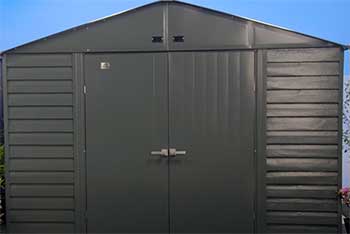
I’ll never forget the day my Arrow shed arrived.
It was early spring 2025, and I was buzzing with excitement to finally clear out my garage.
I’d ordered the Arrow Claremore 10’x14’ steel shed online for about $2,000, thinking it’d be the perfect solution for my tools, lawnmower, and that pile of camping gear my wife keeps nagging me about.
The delivery guy dumped a mountain of boxes at my driveway, and I thought, “No big deal, I’ve assembled IKEA furniture—this can’t be much worse.”
Oh, how wrong I was. The instructions?
A cryptic mess. I’m no stranger to DIY—my husband’s a carpenter, for crying out loud—but even he was scratching his head. The text was vague, and while the pictures helped a bit, it felt like decoding a treasure map with half the clues missing.
We spent a solid 8 hours wrestling with it, and that was with two of us tag-teaming the job. By hour five, I was ready to chuck the whole thing into the neighbor’s yard.
The shed’s thin steel panels were another shock. I could practically feel them flexing under my hands, and aligning the holes for screws was like trying to herd cats—nothing matched up without some serious shimming and swearing.
By the time we got the roof on (a gable design that fought us every step of the way), I was questioning my life choices. It looked decent once it was up, I’ll give it that, but the flimsy vibe lingered.
A week later, a gusty storm rolled through, and I caught myself staring out the window, half-expecting it to take flight. It didn’t, but the dents it picked up told me this wasn’t the fortress I’d hoped for.
That’s when I started digging into reviews and realized I wasn’t alone—others had horror stories too. So, let’s break this down: what works, what doesn’t, and why I’m steering you clear.
Pros of Arrow Sheds: The Silver Lining (Sort of)

Even though my experience left me salty, I’ll give credit where it’s due. Arrow sheds have some perks that might catch your eye—here’s what I found.
- Affordable Price Tag
I can’t knock the price. At $2,000 for a 10’x14’ shed, it’s a steal compared to some wooden or vinyl options that can run you double. Smaller models, like the Arrow Apex Metal Garden Shed 6’x5’, go for as low as $139.99 online.
For budget shoppers, that’s tempting. I snagged mine because I didn’t want to blow the bank, and on paper, it seemed like a no-brainer. You get a decent chunk of storage without needing a second mortgage—hard to argue with that.
- Low Maintenance
Here’s where Arrow shines—or at least, it should. These sheds are made of galvanized steel, so you’re not slapping on wood treatment every year like with a timber shed. I loved the idea of setting it up and forgetting it.
No rot, no termites, just a metal box to dump my stuff in. After assembly, I haven’t had to touch it with a paintbrush or sealant, which is a win for lazy folks like me who’d rather mow the lawn than babysit a shed.
- Decent Looks
Once it’s standing, an Arrow shed doesn’t look half bad. Mine’s got a sleek, industrial vibe that blends into my backyard without screaming “eyesore.” The steel finish is clean, and it’s not as bulky as some plastic sheds I’ve seen.
If aesthetics matter to you, it’s not a total loss—neighbors haven’t complained yet, and that’s saying something in my picky HOA.
- Space for Days
Size-wise, it delivers. My 10’x14’ model swallowed up everything I threw at it—lawnmower, bikes, even that old tent I haven’t used since 2019. Smaller options still pack a punch for tight spaces.
If you’re drowning in clutter like I was, the storage capacity might tempt you to overlook the flaws. It’s functional, I’ll give it that much.
Cons of Arrow Sheds: Where It All Falls Apart
Now, let’s get real—the downsides outweigh the upsides by a mile. Here’s why I’m still fuming about this purchase.
- Flimsy Construction
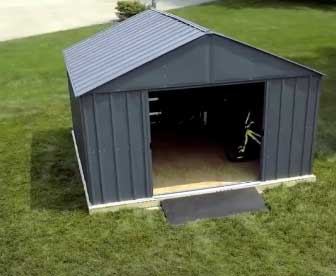
The steel? Thin as paper. Okay, maybe not that bad, but it’s nowhere near the rugged durability I expected.
During assembly, I bent a panel just leaning on it too hard.
Storms leave dents, and I’m paranoid a strong wind might crumple it like a soda can.
Other users online echo this—some even say they’ve seen daylight through the seams. For a “sturdy” metal shed, it feels more like a tin shack.
- Assembly Nightmare
If you enjoy puzzles with missing pieces, you’ll love this. The instructions are a joke—vague text, confusing diagrams, and parts that don’t line up. I spent hours shimming the base just to get the walls to sit right, and the roof?
A two-person circus act. Reviews on sites like secrets-of-shed-building.com call it “time-consuming” and “frustrating”—one guy even ran his over with a tractor. I get it, buddy.
- Poor Customer Service
When I noticed a few missing bolts mid-build, I called Arrow’s support. Crickets. It took days for a response, and by then, I’d already hit the hardware store out of desperation.
Online, folks on Trustpilot and ecommerce sites rant about slow shipping, ignored refunds, and outright arrogance from the company. If something goes wrong, you’re on your own.
- Not Weatherproof Enough
Galvanized steel sounds tough, but mine leaks at the seams during heavy rain. I’ve seen similar gripes—rusted spots, warped panels, you name it. For a shed that’s supposed to stand up to the elements, it’s a letdown.
I’m already dreading the next big storm, and I shouldn’t have to.
- Missing Parts Drama
Check your box twice. Missing nuts, bolts, even entire panels aren’t uncommon, judging by reviews on whatshed.co.uk and beyond. I got lucky with just a few bolts, but others report half-built sheds sitting useless while they chase replacements.
That’s a headache you don’t need.
Maintenance Tips: Making The Best of A Bad Situation
If you’re stuck with an Arrow shed—or still tempted despite my warnings—here’s how to keep it from falling apart faster than it should.
- Seal Those Seams: Water sneaking in is a killer. Grab some silicone caulk and run it along every seam, especially where the roof meets the walls. I did this after my first leak and it’s held up okay so far. Check it yearly—steel might not rot, but rust is still a threat if moisture lingers.
- Anchor It Down: Don’t skip this. Mine wobbled in the wind until I bolted it to a concrete slab. Use ground anchors or concrete screws—whatever fits your setup. It won’t stop dents, but it’ll keep the whole thing from tipping over. Trust me, you don’t want to chase it across the yard.
- Inspect Regularly: Give it a once-over every few months. Look for rust spots, loose screws, or new dents. I caught a wobbly panel early and tightened it before it tore free. A little vigilance goes a long way with something this flimsy.
- Add a Floor: Most Arrow sheds don’t come with one, which is a pain. I built a wooden frame with plywood—keeps stuff dry and adds stability. If you’re on a budget, gravel works too. Just don’t leave it bare or you’ll be mopping mud off your gear.
- Paint It Up: The galvanized finish is low-maintenance, but a coat of rust-resistant paint can extend its life. I haven’t done this yet (lazy, remember?), but I’ve heard it helps fend off corrosion. Pick a sunny day and make it a project—you might even enjoy it.
Comparison With Other Brands: Arrow Vs. The Competition
Alright, let’s put Arrow sheds in the ring with some heavy hitters—Patiowell Plastic Shed, Keter Plastic Shed, and Suncast Shed. I’ve been burned by my Arrow experience, so I’ve scoped out these alternatives to see how they stack up.
Spoiler: they’re not perfect, but they’ve got some serious advantages over my dented steel disaster. Here’s how it breaks down, brand by brand, in a head-to-head showdown.
- Arrow Vs. Patiowell Plastic Shed
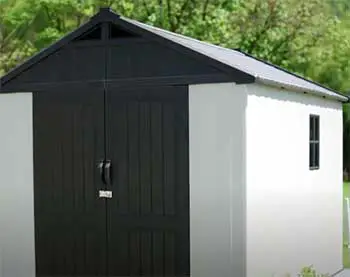
Price-wise, Arrow’s got the edge—I snagged my 10’x14’ steel shed for $2,000, while a Patiowell 10’x12’ plastic shed runs closer to $2,400.
You’re saving a few hundred bucks with Arrow, which is why I bit the bullet.
But here’s the kicker: Patiowell’s resin build feels like a tank compared to Arrow’s flimsy steel.
I bent a panel just leaning on it, whereas Patiowell owners rave about its thick walls shrugging off wind and rain. Assembly’s another story—my Arrow took 8 hours of swearing, misaligned holes, and missing bolts.
Patiowell?
Snap-together parts that actually fit, cutting setup time in half. Weatherproofing leans Patiowell too—my shed leaks at the seams, but Patiowell’s sealed tight, no caulk needed. If I’d known, I’d have paid extra for Patiowell’s peace of mind over Arrow’s budget gamble.
- Arrow Vs. Keter Plastic Shed
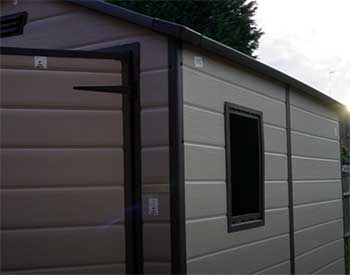
Next up, Keter.
My Arrow shed’s $2,000 price tag undercuts Keter’s Oakland 7.5’x9’ at $1,800, but the size difference makes it a wash—Arrow gives more square footage for the buck.
Still, Keter’s plastic construction blows Arrow away in durability.
My steel dents like it’s auditioning for a crumple zone; Keter’s resin laughs off impacts and UV rays without rusting.
Setup’s where Keter shines—its click-and-lock system had me jealous after my Arrow nightmare of vague instructions and wobbly panels. I spent a day wrestling mine together; Keter users say they’re done in hours.
Maintenance is a tie—both are low-fuss—but Keter’s weather resistance trumps Arrow’s leaky seams. I’d trade my shed’s extra space for Keter’s sturdiness any day.
- Arrow Vs. Suncast Shed
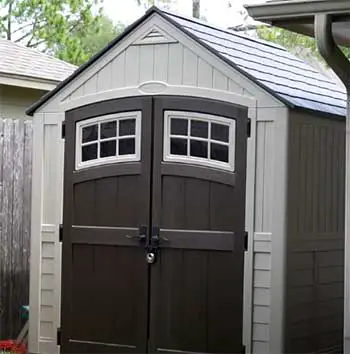
Finally, Suncast.
My 10’x14’ Arrow at $2,000 edges out Suncast’s 8’x10’ resin shed at $2,200 in cost and capacity—more room for my junk, less hit to my wallet.
But Suncast’s build quality makes me regret cheaping out.
Arrow’s thin steel flexes and dents; Suncast’s double-wall resin feels like it could take a beating and still stand tall.
Assembly’s a laugh—Arrow’s cryptic manual and misfit parts ate my weekend, while Suncast’s straightforward design gets kudos for being DIY-friendly.
Looks-wise, Suncast’s molded finish beats Arrow’s industrial box—my HOA might even approve. Weather’s the clincher: my shed’s rust spots and leaks scream “help,” but Suncast keeps water out without extra fuss. I’d pony up for Suncast’s reliability over Arrow’s false economy.
So, where does this leave us?
Arrow’s the cheap date—low cost, big space—but it’s a fling you’ll regret. Patiowell, Keter, and Suncast cost more upfront, but they deliver where Arrow flops: solid builds, easier setups, and actual weather protection.
My Arrow shed’s a constant headache—dents, leaks, wobbles—and I’m kicking myself for not going with one of these instead. If you’re shopping, skip Arrow and invest in something that won’t leave you cursing in the rain. Trust me, I’ve lived the alternative.
Frequently Asked Questions (FAQ)
Not in my book. They’ve got a rep for affordable, low-maintenance sheds, but the trade-off is shaky quality and a brutal setup process. Online reviews—Trustpilot, ecommerce sites—paint a grim picture: thin materials, missing parts, and customer service that ghosts you. I’d say pass unless you’re a masochist with time to burn.
Tough to pin down, but I’d guess 5-10 years if you baby it. The galvanized steel resists rot, but rust and dents pile up fast without care. Mine’s already battered after months—others report similar wear. Compare that to Lifetime’s vinyl sheds lasting 15+ years, and Arrow feels like a short-term fix.
Yeah, they’re a real company—Illinois-based, 50+ years in the game, sold through legit retailers like Argos. But “legit” doesn’t mean “good.” My shed arrived, sure, but the quality and support? Sketchy at best. Plenty of buyers feel scammed by the hype versus reality.
Absolutely, yes. Mine danced in the wind until I bolted it down. Steel’s light, so without anchors—ground stakes or concrete—it’s a kite waiting to happen. Don’t skip this unless you want a backyard disaster.
Conclusion: Steer Clear and Save Your Sanity
Look, I wanted to love my Arrow shed—cheap, spacious, low-fuss storage? Sign me up! But the reality hit hard: flimsy steel, a soul-crushing assembly, and a company that doesn’t care when you’re stuck. It’s not worth the gamble.
You deserve better than a shed that might buckle under a stiff breeze or leave you scrambling for missing parts. Skip Arrow, spend a bit more on a Lifetime or Keter, and thank me when your stuff stays dry and your blood pressure stays low.
